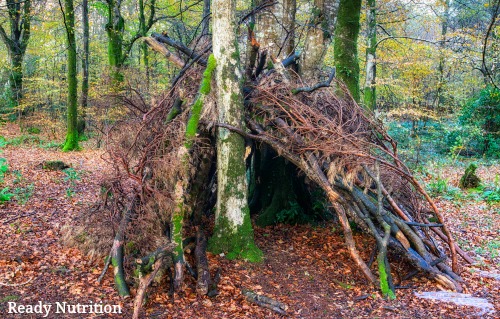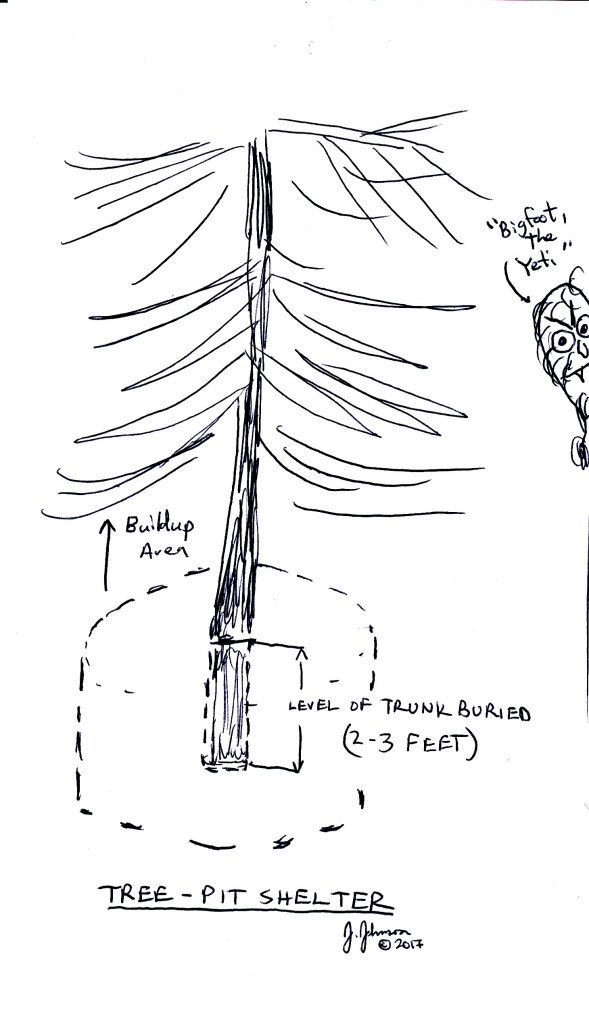
The Simplest Survival Shelters
One answer for you is the lean-to, which is simply a couple of vertical poles jammed into the ground and a cross-pole (or cross-beam, if you will) lashed to the top across the two vertical poles. Then you “lean” other branches across the top edge of your cross-pole, building a triangular shelter for yourself as you create this roof. Ideally the rear can be on the slope of a hill or mountain without any runoff, leaving you a “front” to sit in at the edge of the lean to.
 In areas where heavy snows accumulate, you can also make a tree-pit shelter. Excavate around the trunk of a pine tree with low boughs (a tree with thick branches and the boughs close to the ground). If you have about two to three feet to dig, all the better in this case. You’ll excavate about a 6-7’ diameter “hole” around the tree, and with the snow you remove, stack it up and pack it on the edges of the hole, building it up until you reach those bottom boughs. You can also reinforce the construction by using boughs and dead branches to set the snow on top of. Be creative, and use your imagination to make the situation fit your needs. You want to make a front “gap” for yourself to squeeze through, and maybe a “door” out of pine boughs to close the gap off.
In areas where heavy snows accumulate, you can also make a tree-pit shelter. Excavate around the trunk of a pine tree with low boughs (a tree with thick branches and the boughs close to the ground). If you have about two to three feet to dig, all the better in this case. You’ll excavate about a 6-7’ diameter “hole” around the tree, and with the snow you remove, stack it up and pack it on the edges of the hole, building it up until you reach those bottom boughs. You can also reinforce the construction by using boughs and dead branches to set the snow on top of. Be creative, and use your imagination to make the situation fit your needs. You want to make a front “gap” for yourself to squeeze through, and maybe a “door” out of pine boughs to close the gap off.
The principle being to create walls of snow that extend to the thick tree-boughs. The tree will be your insulation topside, and the walls of snow akin to a semi “igloo” that will protect you on the sides.
Reinforce those walls by placing branches on the inside vertically, stuck into the ground, or use a foam pad to run around the walls of the pit (Army issue ones work well). Pack the top of the wall before putting branches and snow on the sides to build it up. Don’t build a fire in the thing, unless you want to risk the fate of Jack London’s “To Build a Fire” character and risk bringing stuff down on top of you to smother you. Also, don’t pick a tree heavily laden with a billion pounds of snow.
Why These Shelters Are Ideal
The principle is to crawl in this thing, taking support against the tree (lean against it to rest and sleep). Even if you were buried, the tree itself will protect you and create an air pocket when you lean against it. This type of shelter will buy you some time until you can build something a little more permanent. If you did what I advised many moons ago, and packed your “A-bag”/bug-out happy-camper-survivor bag the way I advised, it’s packed per the season, and you should have a poncho and poncho liner in it. The poncho can either be stretched out on the ground for a ground-cover, or used to solidify a lean-to and make it more waterproof.
The tree-pit shelter is for when you need to get out of the elements quickly. If that can’t be done, you can dig a snow-cave for yourself. With the poncho and/or a ground pad, you can insulate yourself from the ground and “hole up” in this snow cave (nothing more than a “spider hole” to protect you from the bite of the elements) and allow your body heat to warm up the hole. It is the same principle that sled dogs use when they dig holes in the snow and bury themselves. The principle is sound and can work for you as well.
Also for the tree-pit shelter: try not to pick a tree that is growing on the side of a mountain or hill. You don’t need an avalanche to ruin your day on this one. The lean to you can get out of. Let the tree-pit shelter be on fairly-level ground, if you can make it so, and check it out thoroughly beforehand. Be prudent and carry your pack with you should you have to leave the vehicle. Practice building these shelters and familiarize yourself with them when you have the time, prior to an emergency occurring. Stay warm, drink coffee, and take care of one another! JJ out!
This article was originally published at Ready Nutrition™ on January 31st, 2017







Thanks for the article.